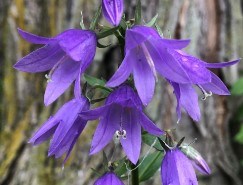The fourth and last session of the Cochrane Environmental Action Committee’s Living Sustainably speaker series is set for Saturday April 13th at 1pm at Frank Wills Hall.
The talk is about flora and fauna invasive species in and around Cochrane. And there are many. Canada thistle, yellow clematis, baby’s breath and the notorious creeping bell flower, to name just a few. Come learn about what other species are present, how to identify and strategies on proper removal and disposal.
Presenter Jade Patterson from Blooming Bee Gardening which is a Calgary-based business that specializes in creating and maintaining water sustainable gardens that promote the growth of plants native to the area. Their eco-friendly practices and use of sustainable materials are designed to reduce the impact on the environment, while creating beautiful and functional gardens that support local ecosystems.
Invasive alien species or invasive species are non-native species that have been introduced, intentionally or unintentionally, from other countries or ecosystems and threaten Alberta's ecosystems and biodiversity.
What the Government of Alberta is doing about invasive species
The Alberta government is responsible for the key role of control work; however, it is also taking other actions on invasive alien species, such as: developing educational materials about what invasive species are and their impacts; identifying the public's role in helping with solutions; working with stakeholder groups to coordinate control efforts, and, enhancing legislation, regulations and risk assessment tools.
Government, academics, industry, stewardship groups and the public all have a role to play in increasing awareness about invasive species. These sectors are working together to prevent invasive species from establishing and spreading.
The province’s invasive species website states: “This collaborative approach to invasive species management aims to improve awareness and preparedness, enhance communication and coordination, and improve resource allocation to decrease the risk of invasive species in Alberta.”
According to the International Union of Conservation and Nature (IUCN), invasive species are the second most common threat associated with species that have gone completely extinct and are the most common threat associated with extinctions of amphibians, reptiles, and mammals. Compared to other threats to biodiversity, invasive species rank second only to habitat destruction.
What are Invasive Species?
Invasive species are plants, animals, or other organisms that are not native to the ecosystem under consideration and whose introduction causes or is likely to cause economic or environmental harm or harm to human health.
Invasive species out-compete native species for food and space, alter or destroy ecosystems, disrupt food sources, and introduce parasites and disease. They also harm local economies by reducing crop yields and livestock forage production, decreasing property values, interfering with irrigation and water control structures, and discouraging outdoor recreation. Invasive species cost Alberta and Canada billions of dollars a year.
Registration for the talk is free and can be accessed at (https://www.eventbrite.ca/e/living-sustainably-series-ii-invasive-species-101-tickets-876399282847).
The presentation will be on April 13, from 1 to 2:30 pm at the Frank Wills Memorial Hall, 405-1 St. E in Cochrane.




